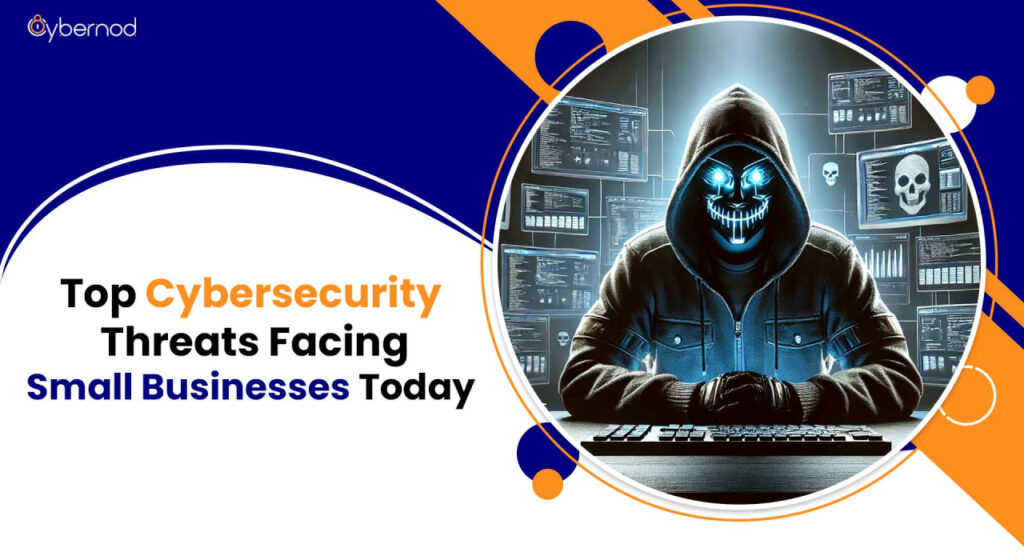
The commercial landscape thrives on the constant exchange of information. For small businesses, this digital environment unlocks a world of opportunity, facilitating communication, collaboration, and growth. However, this very reliance on technology introduces a critical vulnerability: cyberattacks.
The frequency and sophistication of cyberattacks are on a sharp incline. According to a 2023 report by Verizon, 43% of data breaches involved small businesses, highlighting their susceptibility. These attacks can have devastating consequences. A single data breach can result in the loss of sensitive customer information, financial disruption from stolen funds or halted operations, and irreparable reputational damage.
In the face of this evolving threat landscape, robust cybersecurity measures are no longer a luxury, but a necessity for small businesses. This article delves into the top cybersecurity threats currently plaguing small businesses and equips them with actionable strategies for mitigation. By understanding these threats and implementing effective safeguards, small businesses can navigate the digital age with confidence and resilience.
Understanding the Threat Landscape

The Cybersecurity Fortress: Protecting Core Principles
Cybersecurity refers to the practice of protecting information systems, networks, and data from unauthorized access, use, disclosure, disruption, modification, or destruction. At its core, cybersecurity revolves around three fundamental principles:
- Confidentiality: Ensuring that only authorized users can access sensitive information.
- Integrity: Guaranteeing the accuracy and completeness of data throughout its lifecycle.
- Availability: Maintaining the accessibility of critical systems and resources for legitimate users.
These principles form the foundation for a robust cybersecurity posture, safeguarding the digital assets that fuel a small business’s operations.
The Ever-Shifting Battleground
The cybersecurity threat landscape is a dynamic environment, constantly evolving as cybercriminals develop new techniques and exploit emerging vulnerabilities. Unlike a static castle wall, cybersecurity requires continuous vigilance and adaptation. New attack vectors emerge regularly, demanding a proactive approach to defense.
Motivations Unveiled: Why Do They Attack?
The motivations behind cyberattacks are as varied as the attackers themselves. Financial gain remains a primary driver, with criminals targeting sensitive data like credit card numbers or intellectual property for sale on the black market. Espionage is another significant concern, as attackers might seek to steal confidential business information for competitive advantage. Disruption, through acts like data breaches or denial-of-service attacks, can also be a motivator, aiming to cripple a business’s operations and damage its reputation.
A Rogues' Gallery: Common Cyberattacks
The following table outlines some of the most prevalent cyberattacks targeting small businesses:
| Cyberattack | Description |
|---|---|
| Malware (Malicious Software) | A broad term encompassing software designed to harm a system, steal data, or disrupt operations. Examples include viruses, worms, and Trojan horses. |
| Ransomware | A specific type of malware that encrypts a victim's data, rendering it inaccessible. Attackers then demand a ransom payment to decrypt the data. |
| Phishing | Deceptive emails or messages designed to trick recipients into revealing sensitive information or clicking malicious links. |
| Social Engineering | Psychological manipulation tactics used to exploit human vulnerabilities and gain access to systems or information. |
| Denial-of-Service (DoS) Attack | An attempt to overwhelm a website or server with traffic, making it unavailable to legitimate users. |
Understanding these threats is the first step towards building a comprehensive cybersecurity strategy for your small business.
Top Cybersecurity Threats for Small Businesses
Small businesses, while agile and adaptable, often lack the robust cybersecurity resources of larger corporations. This vulnerability makes them prime targets for cybercriminals. Here, we delve into five of the most prevalent cyber threats plaguing small businesses and explore mitigation strategies.
Phishing and Social Engineering

Phishing attacks exploit the inherent trust and human emotions within employees. Deceptive emails or messages, often meticulously crafted to mimic legitimate sources like banks, credit card companies, or even colleagues, arrive in inboxes. Social engineering tactics leverage these emotions, creating a sense of urgency, fear, or curiosity to manipulate recipients. For instance, a phishing email might warn of an imminent account closure unless the recipient clicks a link to “verify” their information. This link, however, leads to a fraudulent website designed to steal login credentials or personal details.
Impact: Phishing attacks can result in compromised login credentials, data breaches, and significant financial losses for small businesses. Stolen credentials can be used to access sensitive data, divert funds, or launch further attacks.
Mitigation: Employee training and awareness programs are crucial. Educate employees on the red flags associated with phishing attempts, such as suspicious sender addresses, grammatical errors, unsolicited attachments, and a strong sense of urgency. Implement multi-factor authentication (MFA) to add an extra layer of security by requiring a secondary verification code beyond just a password.
– The Federal Trade Commission (FTC) provides extensive resources on identifying and avoiding phishing scams.

Malware and Ransomware
Malware (malicious software) encompasses a broad spectrum of programs designed to disrupt, damage, or steal information from a system. Viruses can self-replicate and spread across a network, while worms exploit vulnerabilities to propagate themselves. Trojan horses disguise themselves as legitimate software to gain access and potentially steal data. Ransomware is a particularly devastating form of malware that encrypts a victim’s data, rendering it inaccessible. Attackers then demand a ransom payment to decrypt the data.
Impact: Malware attacks can disrupt business operations, damage data integrity, and lead to financial losses through stolen information or compromised systems. Ransomware attacks can cripple a small business by halting operations and forcing potentially extortionate ransom payments to regain access to critical data.
Mitigation: Implement a reputable antivirus program with real-time scanning capabilities to detect and quarantine malware threats. Regularly update software and operating systems to patch vulnerabilities that cybercriminals exploit. Maintain consistent backups of critical data to facilitate recovery in case of a ransomware attack. Backups stored offline or in the cloud add an extra layer of protection against ransomware encryption.
Weak Passwords and Poor Access Management
Weak passwords, such as dictionary words or personal details, are easily cracked by cybercriminals using brute-force attacks or readily available password-cracking tools. Poor access management practices exacerbate vulnerabilities further. Granting excessive privileges to users who only require access to specific functions creates a larger attack surface if credentials are compromised.
Impact: Weak passwords and poor access management significantly increase the risk of unauthorized access to systems and sensitive data. This can lead to data breaches, financial losses, and reputational damage for the small business. Leaked customer information or internal financial data can erode trust and damage a business’s reputation.
Mitigation: Enforce strong password policies, requiring a combination of uppercase and lowercase letters, numbers, and symbols. Encourage the use of unique passwords for different accounts and consider password management tools to generate and store complex passwords securely. Implement the principle of least privilege, granting users only the minimum access level required for their job functions. This minimizes the potential damage if a single account is compromised.
Risk Assessment and Mitigation Strategies

In the ever-evolving cybersecurity landscape, proactive measures are essential. Conducting a cybersecurity risk assessment is a crucial first step for small businesses. This comprehensive evaluation involves identifying vulnerabilities within a company’s systems and processes that could be exploited by cybercriminals.
Benefits of a Risk Assessment:
- Prioritize Threats: A risk assessment sheds light on the most significant threats facing a small business, enabling them to prioritize resources and focus on areas with the highest potential impact.
- Allocate Resources Effectively: By understanding the specific vulnerabilities within their systems, small businesses can allocate their cybersecurity budget strategically, investing in the most effective mitigation strategies.
Many free or low-cost resources are available to assist small businesses with conducting basic risk assessments. The Small Business Administration (SBA) website offers valuable guidance and tools to help small businesses navigate the complexities of cybersecurity, including resources for conducting free risk assessments.
By proactively identifying and addressing vulnerabilities, small businesses can significantly enhance their cybersecurity posture and safeguard their critical data.
The ever-present threat of cyberattacks underscores the critical need for robust cybersecurity practices in today’s digital landscape. Small businesses, despite their agility, are particularly vulnerable due to a lack of extensive resources. By understanding prevalent threats, implementing mitigation strategies, and conducting regular risk assessments, small businesses can significantly enhance their cybersecurity posture.
This article has provided a foundational understanding of the top cybersecurity threats facing small businesses. However, cybersecurity is an ongoing process. The Small Business Administration (SBA) and the National Institute of Standards and Technology (NIST) offer a wealth of free resources to guide small businesses on their cybersecurity journey. For more complex needs, consider consulting professional cybersecurity services to develop a comprehensive security strategy.
The ever-present threat of cyberattacks underscores the critical need for robust cybersecurity practices in today’s digital landscape. Small businesses, despite their agility, are particularly vulnerable due to a lack of extensive resources. By understanding prevalent threats, implementing mitigation strategies, and conducting regular risk assessments, small businesses can significantly enhance their cybersecurity posture.
For those businesses leveraging cloud-based solutions, securing this environment is paramount. Our follow-up article, “[Cloud Security Best Practices for Small Businesses],” dives deeper into specific strategies to safeguard your valuable data in the cloud. By implementing these best practices, you can significantly reduce the risk of data breaches and ensure the continued success of your small business.
Categorized in:
Comments